49 F. high yesterday in St. Cloud.
59 F. average high on April 20.
67 F. high on April 20, 2016.
April 21, 1910: A snowstorm hits northeastern Minnesota. Duluth picks up 6.5 inches.

Spring Regains Its Bounce with a Lukewarm Blue Sky
Believe
it or not meteorologists are sensitive to charges of hyping the
weather. We'd still rather hear "You're crying wolf again!" to "Where
were you? The tornado struck without warning!" Doppler radar technology
is good, and getting better, but it's not perfect. We still can't
predict precisely when and where a tornado will touch down more than a
few minutes in advance. The atmosphere may be ripe for tornadoes, but
exactly where they spin up is still chaos-theory.
An
article in today's weather blog suggests that NOAA forecasters,
nationwide, are issuing fewer tornado warnings, and the "False Alarm
Rate" is dropping, a good thing. But average lead time for tornado
warnings has dropped from 15 minutes in 2011 to 8 minutes in 2015, a
potentially troubling trend.
Nothing
but severe clear today as spring fever returns. Expect 60s and blue sky
for Earth Day activities on Saturday. A close brush with a cooler front
sparks more clouds and spotty showers north of MSP Sunday. Showery rain
returns Monday.
NOAA data: March was the 628th warmer-than-average month in a row, worldwide.
Americans Are Getting Less Advance Notice for Tornadoes, as Researchers Struggle to Understand Why.
Are we drowning in too much data? With Doppler radar technology and new
research coming online you would think that all the trends would be
positive, but Jason Samenow explains the challenges faced by warning
meteorologists at Capital Weather Gang: "...About
a decade ago, the tornado false alarm rate was about 80 percent. This
meant for every five tornado warnings issued, only one tornado would
occur. This false alarm percentage has since dropped to 70 percent. In
sum, it appears Weather Service forecasters are not preparing people for
tornadoes as well as they did five years ago, but also are
not needlessly warning them as much. Brooks says these two developments
are related and tied to what’s going on inside the forecaster’s
head when forced with the stressful decision of whether to issue a
warning. In recent years, Brooks said, the Weather Service has placed
“increased emphasis” on reducing false alarm rates, which may be
motivating some forecasters to issue fewer warnings. Brooks referred
to “unofficial efforts,” not policy, within the agency to curb false
alarm frequency..." (Graphic credit: National Weather Service).

Fond Memories.
Remember April, 2013? The MSP metro area picked up 17.9" of snow. I
distinctly remember that (most) people weren't terribly happy that
spring. So far April 2017 has brought half an inch of slush. Remind me
not to whine about the rain.
Heat Waves Kill. From 2000 to 2010 at least 35 deaths were directly attributable to extreme heat in Minnesota. The Minnesota Department of Public Safety explains the different criteria involved in setting expectations for heat-related problems: "The National Weather Service issues the following heat-related products as conditions warrant:
Excessive Heat Outlooks:: are issued when the potential exists for an excessive heat event in the next 3-7 days. An Outlook provides information to those who need considerable lead time to prepare for the event, such as public utility staff, emergency managers and public health officials.
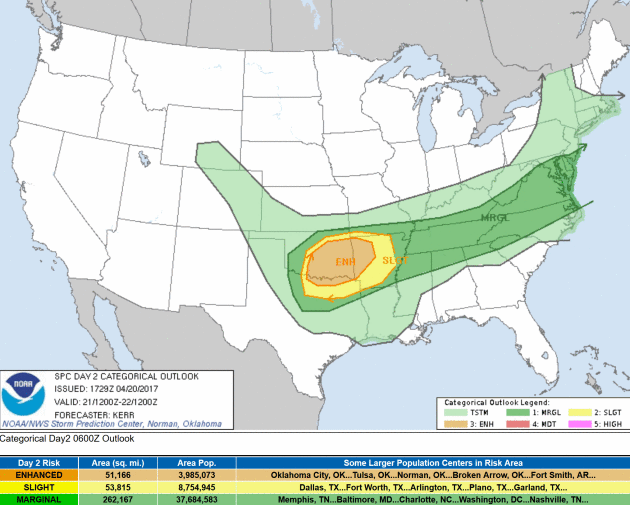
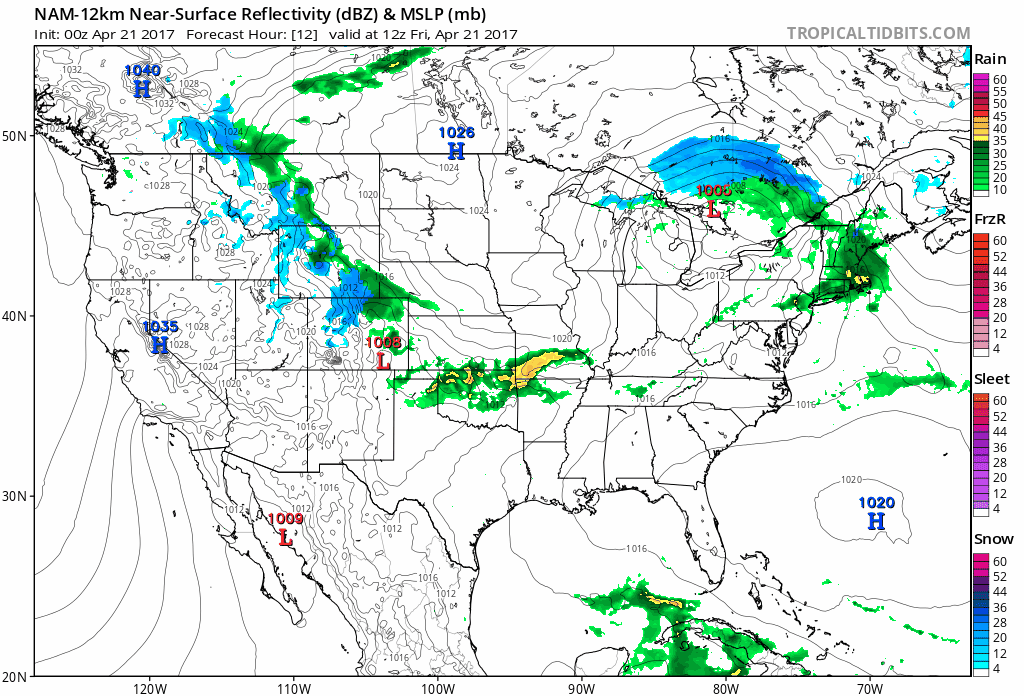
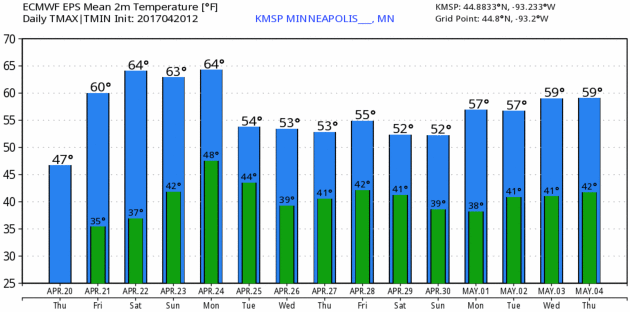

Excessive Heat Outlooks:: are issued when the potential exists for an excessive heat event in the next 3-7 days. An Outlook provides information to those who need considerable lead time to prepare for the event, such as public utility staff, emergency managers and public health officials.
Excessive Heat Watches:
are issued when conditions are favorable for an excessive heat event in
the next 24 to 72 hours. A Watch is used when the risk of a heat wave
has increased but its occurrence and timing is still uncertain. A Watch
provides enough lead time so that those who need to prepare can do so,
such as cities officials who have excessive heat event mitigation plans.
Excessive Heat Warning/Advisories
are issued when an excessive heat event is expected in the next 36
hours. These products are issued when an excessive heat event is
occurring, is imminent, or has a very high probability of occurring. The
warning is used for conditions posing a threat to life. An advisory is
for less serious conditions that cause significant discomfort or
inconvenience and, if caution is not taken, could lead to a threat to
life.
Friday Severe Risk Southern Plains.
Expect large hail and a few tornadoes later today from near Tulsa and
Oklahoma City to Broken Arrow and Fort Smith - severe storms brushing
Dallas, Texas. Map: NOAA SPC.

When In Doubt - Predict Rain.
High pressure carves out some blue sky today and Saturday from the
Upper Midwest into the Great Lakes and New England, but a parade of
soggy storms is forecast to track from near Kansas City to Washington
D.C. California and the southwestern USA stays generally dry; another
smear of heavy rain approaching the Pacific Northwest by Sunday. 84-hour
NAM: NOAA and Tropicaltidbits.com.
Warm Fronts In No Great Hurry.
Like most Minnesotans I am perfectly content with 60s, and frankly 50s
feel like a (bad) vacation right now, so I'm not complaining. Expect 60s
today into Monday before a cool correction by next Tuesday. Twin Cities
ECMWF meteogram: WeatherBell.
Nagging Hints of a Blocking Pattern.
There isn't much consistency with long-range models (what a shock) but
the latest 2-week GFS outlook suggests a weak blocking pattern the first
week of May; seasonably warm weather east of the Rockies.
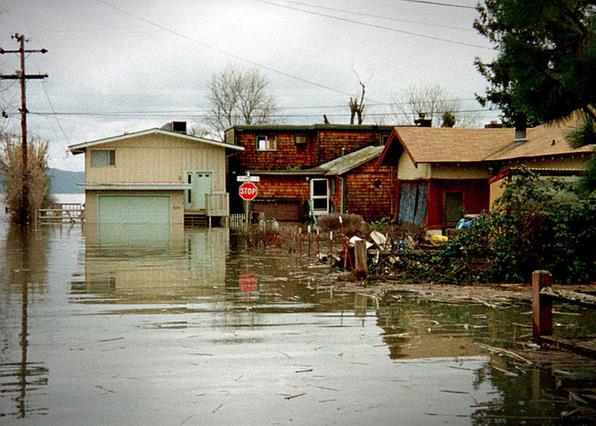
Minnesota's Biggest Weather Killer is Flooding.
Tornadoes are photogenic, hypnotic and terrifying; they tend to hog
media airtime at a local and national level. But lately flooding has
been Minnesota's biggest weather killer, with 13 deaths since 1993.
Nationwide 75 percent of flash flood deaths occur at night; half of all
victims perish in their vehicles, trying to drive through flooded roads.
A reminder than 6 inches of moving water can knock you off your feet. 2
feet of water can float your car or SUV, with tragic consequences. NOAA
says it best: "turn around - don't drown." (File photo: Dave Gatley,
FEMA).
Flooding: Minnesota's Biggest Weather Killer. Minnesota's Department of Public Safety explains: "Nationally,
floods claim nearly 200 lives each year, force 300,000 persons from
their homes and result in property damage in excess of $2 billion. In
Minnesota, floods kill more people than any other weather event; 15
people have died in floods since 1993. About 75 percent of flash-flood
deaths occur at night. Half of the victims die in automobiles or other
vehicles. Many deaths occur when people drive around road barricades
that clearly indicate that the road is washed out ahead. In 2007, a
deadly flood occurred August 18-19 in southeast Minnesota, killing seven
people and destroying hundreds of homes and businesses. A state record
for rainfall was set at Hokah — 15.1 inches in 24 hours — while several
other areas received more than eight inches of rain..." (File image: NOAA).
Bathtubs: Last Line of Tornado Defense.
If you don't have a basement the safest place to ride out a tornado is a
small, interior room on the ground floor. The more walls between you
and the tornado, the better. People have survived tornadoes by hiding in
their bathtubs, with a mattress above their heads. You probably won't
see a tornado this year but lightning is pervasive. NOAA reminds us to
avoid plumbing, windows, doors and porches when lightning is flickering
overhead. Smartphones are fine, but stay off corded phones. Your home,
office, store or vehicle offers the best protection.
Tahoe Got So Much Snow You Can Ski All Winter.
Record warmth, more water in the air, and that translates into heavier
rains (and snows). 63 feet of snow in the Sierra Nevada isn't going
anywhere anytime soon, resports Bloomberg Pursuits: "Don’t
have Fourth of July plans yet? How about a ski weekend … at Lake Tahoe?
That’s what Andy Wirth, chief executive officer of Squaw Valley,
is proposing after an historically snowy winter that surpassed 700
inches of snowfall this week. He’s so sure that this season’s snowfall
will stick around, he’s hoping to stay open straight through the summer
months and into the 2017-18 winter season. “I’ll drop something on you
that you may not be expecting,” Wirth told Truckee Tahoe Radio on Saturday. “We are actually considering staying open through the summer and fall so it becomes the ’16-17-18 season..." (Photo credit: Squaw Valley).
El Nino: Watching,Waiting For Signs It Could Return. AL.com has an update: "La Nina is history -- but El Nino might not be gone for long. That's according to the latest monthly discussion on
the matter from climate researchers. ENSO-neutral conditions prevailed
in March, and could continue though at least the rest of the spring,
according to the report from a group that includes NOAA's Climate
Prediction Center, the National Centers for Environmental Prediction,
the National Weather Service and the International Research Institute
for Climate and Society. However, researchers believe there are
increasing odds of El Nino returning by the late summer or fall..."
Graphic credit: "The
tropical Pacific was giving mixed signals in March. Some areas (in
blue) were cooler than average while others (in red) were warmer." (NOAA).

The Nation is Immersed In Its Warmest Period In Recorded History. Jason Samenow reports at Capital Weather Gang: "The
U.S. is enduring a stretch of abnormally warm weather unsurpassed in
the record books, and it shows no immediate sign of ending. The latest
one-, two-, three-, four- and five year periods — ending in March — rank
as the warmest in 122 years of record-keeping for the Lower 48 states,
according to data from the National Oceanic and Atmospheric
Administration. Freakish bouts of warm weather have accompanied
this long period of historic warmth, unlike anything previously
experienced. In February of this year, Chicago witnessed multiple 70-degree days for the first time and a record snowless streak. Denver hit 80 degrees as early as it ever has (in a calendar year). Meanwhile, spring arrived as much as three weeks early in the South..."
Graphic credit: "U.S. temperature rankings over the last 12, 24, 36, 48 and 60 months." (NOAA).
March Data Confirms Earth Is On a Hot Streak. More perspective from Climate Central: "To say the world is having a streak like no other is an understatement. Global warming has made cold scarce
on a planetary scale. This March clocked in as the second warmest March
on record when compared to the 20th century average, according to newly
released data from the National Oceanic and Atmospheric
Administration. NASA data published last week came to the same conclusion, comparing
temperatures to a 1951-1980 baseline. The NOAA data shows the planet
was 1.9°F (1.05°C) above the 20th century average for March, the first
time any month has breached the 1°C threshold in the absence of El Niño.
This March is the latest freakishly hot month following three years in a
row of record heat..."
Extreme 4K Footage Puts You Right Next to a Massive Tornado in Colorado. The video is incredible; here's a link and excerpt at PetaPixel: "Incredible… and terrifying. Last year, extreme storm chaser Reed Timmer
got up close and personal with an EF-2 tornado outside of Wray, CO, and
captured 4K footage of the twister that will leave you slack-jawed. The
video was published back in May of 2016, around the same time Timmer
uploaded the 360 footage we featured here, but we somehow missed the ultra-high definition 4K footage until yesterday when it blew up again on Reddit..."
Greensburg To Remember Tornado. The tornado that hit Greensburg, Kansas was a monster, a huge, violent wedge torando. Dodge City Daily Globe has a story on efforts to commemorate the 10 year anniversary of that horrible day: "Greensburg was destroyed almost 10 years ago by a deadly tornado. Since then the community has embraced the green in Greensburg. The community will hold several 10th anniversary events beginning May 4 and concluding May 7. City officials are currently trying to finish a sidewalk as part of Starlight Public Art Park, located kitty-corner from city hall..."
Photo credit: "The center of Greensburg is shown on May 17, 2007, in this FEMA photo. the town resembles a bomb site 12 days after it was hit by an EF-5 torando. The community will hold a 10th anniversary event which remembers the night of the tornando, but also the spirit of the community." Photo by Greg Marshall/FEMA.

Image credit: "Shian-Jiann “S. J.” Lin’s program will power short-term weather forecasts and long-term climate simulations." JEFF FUSCO.

See The Best and Worst Places for Breathable Air in the U.S. It turns out the cleanest air isn't always in rural areas, according to new research highlighted at National Geographic: "The air Americans breathe is cleaner than ever, thanks to cleaner power plants and cleaner vehicles. That milestone is all the more impressive when considering progress has been achieved in spite of increases in population, energy use, and miles driven. Yet nearly 40 percent of Americans—125 million people—still live where the air is unhealthy to breathe. Those findings are contained in the American Lung Association’s annual State of the Air report, released Wednesday...Six cities ranked on all three pollutant lists for cleanest cities. They had no high ozone or high particle pollution days, and were among the 25 cities with the lowest year-round particle levels. Five cities are repeaters: Burlington, Vermont, Cape Coral-Fort Myers, Florida, Elmira-Corning, New York, Honolulu, Hawaii, and Melbourne-Titusville-Palm Bay on Florida’s Space Coast..."
Photo credit: Fidel L Soto.
Map credit: "Locations and plastic concentrations of the sites sampled. The white area shows the extension of the polar ice cap in August 2013, and green curves represent the North Atlantic Subtropical Ocean Gyres and the Global Thermohaline Circulation poleward branch." (Andres Cozar)
Photo credit: "This drone footage shows a reclaimed strip mine in Pike County, Ky., where investors are studying the potential for a large solar panel array. Video provided by Berkeley Energy Group." Berkeley Energy Group.
To Build a More Resilient Electric Grid, Many Believe The Answer Is Going Small. Bostonomix at WBUR.org reports: "Today,
nearly half a million miles of high-voltage transmission lines
crisscross the country, but the people planning the future of America's
electric grid are thinking small. They say we should build microgrids — small, local systems that could connect and disconnect.
Advocates say the microgrid transformation of our electric
infrastructure would make it more resilient to cyberattacks, the effects
of nuclear weapons and climate change, and better able to handle
electricity generated by renewable resources, such as wind and solar..."
Image credit: North American Energy Advisory.
TODAY: Much-need sunshine. Winds: N 5-10. High: 61
FRIDAY NIGHT: Clear and cool. Low: 39
SATURDAY: Plenty of sunshine, nicer day of the weekend. Winds: W 7-12. High: 66
SUNDAY: Clouds increase, spotty shower or sprinkle. Winds: E 8-13. Wake-up: 45. High: 62
MONDAY: Heavier, more widespread showers, possible T-storms. Winds: S 15-25. Wake-up: 50. High: 65
TUESDAY: Partial clearing, showers linger southern Minnesota. Winds: NW 10-15. Wake-up: 46. High: 57
WEDNESDAY: Mix of clouds and some sun, cooler than average. Winds: NW 5-10. Wake-up: 40. High: 56
THURSDAY: Chance of steadier, heavier rain again. Winds: E 10-15. Wake-up: 43. High: 53
Climate Stories....
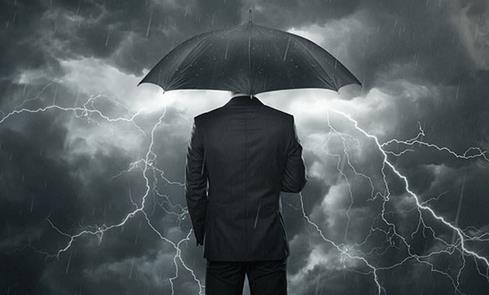
Photo credit: investinmiami.com.
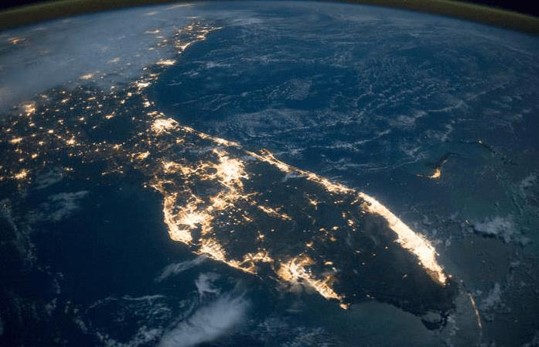
The Word on Global Warming: "It's Happening, It's Arrived." We've gone from theory to reality; we can measure rising seas. Here's an excerpt from The Sarasota Herald-Tribune: "For those who think climate change is a myth or a product of normal cyclical changes in the environment, University of Miami geological sciences professor Harold Wanless has a message: It’s already here. “The important thing to understand about global warming is: It’s happening, it’s arrived,” Wanless told about 150 people at University of South Florida Sarasota-Manatee’s Selby Auditorium Tuesday evening. “That’s where we are.” Wanless was the keynote speaker at the Suncoast Climate Change Symposium, which also featured the city of Sarasota’s sustainability manager, Stevie Freeman-Montes. The academic focused most of his talk on ocean warming and sea-level rise, two topics that are at the forefront of many Floridians’ minds. According to Wanless, 93.4 percent of global warming heat is accumulating in the oceans. By 2100, the world could see between 4.1 and 6.6 feet of sea-level rise, according to a model cited by Wanless developed by the National Oceanic and Atmospheric Administration in partnership with other organizations..." (File image: NASA).
- The deadly 2003 European heat wave, which killed more than 20,000 people, was the first major focus of an attribution study. The lead scientist reanalyzed the data in 2011. The heat wave is now thought to have been responsible for about 64 deaths in London and 506 in Paris.
- Heavy rain in southern Louisiana last August was studied by the World Weather Attribution project, which concluded that global warming had upped the odds considerably. By contrast, the central European flooding of May and June 2013 showed no such human fingerprints [see page S69 here: pdf].
- An April 2015 study in Nature Climate Change found that about 75 percent of major heat events and 18 percent of heavy precipitation events are attributable to global warming..."
… I reali[z]ed that co2 has an extremely long lifespan in the atmosphere compared to these other gases, and it’s the only one that we are directly responsible for producing via fossil fuels etc.Another prevalent science-assisted conclusion was the ever-increasing evidence that the climate is changing. "The relentless accumulation of data finally became inescapable. The amount of measurable, observable proof was just too much to ignore. For me it was when I saw a simple chart – world temp and world CO2 levels, on [a] marked timeline..."
Antarctica Meltwater Rivers Raise Concerns About the Fate of the Continent.
We still don't know what we don't know. But getting a handle on melting
is critically important when it comes to predicting the rate of future
sea level rise. Here's an excerpt from Nexus Media: "...Recently,
however, Greenland has started melting from the middle. Pools of water
are forming atop the ice sheet in the warmer months and then draining
out to sea. Scientists have now discovered the same thing is happening
in Antarctica. Two new studies published in the journal Nature catalogue the melting and explain what it could mean for sea-level rise. In the first study,
researchers examined decades of photos from satellites and military
aircraft. They documented hundreds of meltwater channels around the
perimeter of the continent. They traced some streams deep into
Antarctica’s frozen interior and discovered ponds of meltwater more than
4,000 feet above sea level, where no one expected to find liquid H2O..."
Image credit: "The Nansen Ice Shelf in Antarctica." Source: C. Yakiwchuck/European Space Agency
How a Melting Arctic Changes Everything. Bloomberg has an effective info-graphic and explainer on why we should all be paying close attention to changes in the Arctic: "...Sea
ice has diminished much faster than scientists and climate models
anticipated. Last month set a new low for March, out-melting 2015 by
23,000 square miles. Compared with the 1981-2010 baseline, the average
September sea-ice minimum has been dropping by more than 13 percent per
decade. A recent study in Nature Climate Change estimated that from
30-50 percent of sea ice loss is due to climate variability, while the
rest occurs because of human activity. Receding ice decreases the
Earth’s overall reflectivity, making the Arctic darker and therefore
absorbing even more heat..."
Graphic credit: Danish Meteorological Institute and Nico Sun
I'm a Tea Party Conservative. Here's How to Win Over Republicans on Renewable Energy. Vox has a terrific interview with Debbie Dooley: "...Dooley is a conservative, gun-owning Trump supporter who also happens to be a co-founder of the Tea Party. Dooley runs Conservatives for Energy Freedom,
where she advocates for the expansion of renewable energy and for cuts
to government regulations she believes hinder that growth. Through her
efforts, she has even won over unlikely allies such as Al Gore.
According to Dooley, the problem with her fellow conservatives is that
“they've been brainwashed for decades into believing we're not damaging
the environment.” As a result, Dooley speaks with them about renewable
energy in a political language conservatives respect, using phrases like
energy freedom, energy choice, and national security..."
Photo credit: "Larchmont-Edgewater, a Norfolk, Va. neighborhood frequently plagued by floods. The house in the center has been raised above flood levels, the one at left has not." Benjamin Lowy for The New York Times.
No comments:
Post a Comment